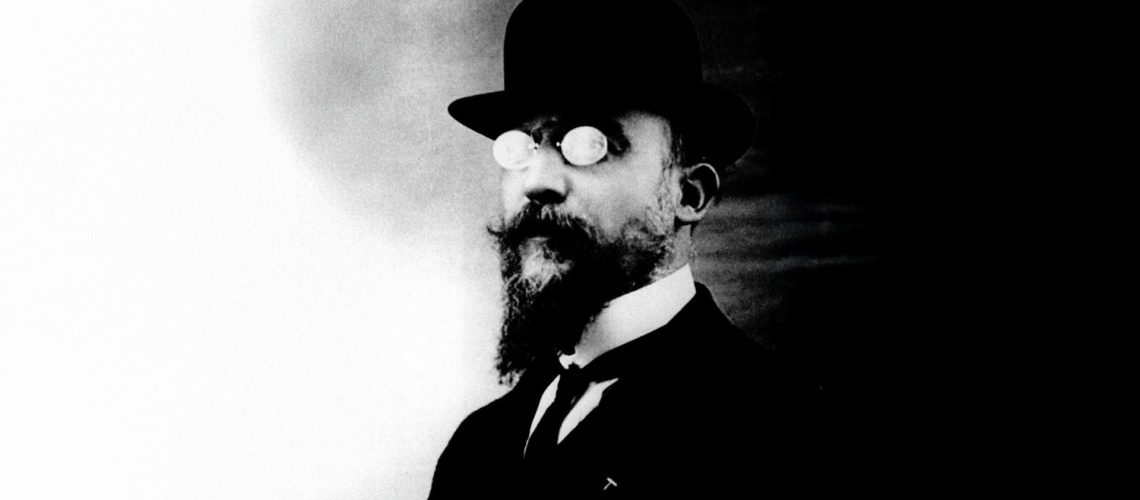Today, July 1st, 2025, marks the hundredth anniversary of the death of Erik Satie – that whimsical genius whose sparse piano playing and witty notations captivate to this day. Pour yourself a glass of Calvados, because this man deserves more than just Bach in the background. Absinthe was his drink – and beer – but we know too much of that inevitably leads to cirrhosis of the liver. Satie was indeed a heavy drinker his entire life and died in 1925 at only 59 from its consequences. So, it’s better to enjoy in moderation – otherwise, like Satie, you might end up in the clinic.
From Country Boy to Parisian Provocateur
Born in Honfleur in 1866 as Eric Alfred Leslie Satie, he spent parts of his childhood in rural Normandy. He was drawn to Paris early on, where at age eleven he was accepted into the prestigious Conservatoire – but his education there was disastrous. Satie simply wasn’t a model student: his teachers described him as “gifted, but lazy” and soon even as “the laziest student at the Conservatoire.” He was ultimately expelled without a diploma. But that didn’t stop him from gaining a foothold in Montmartre’s creative milieu. In the late 1880s, Satie worked as a pianist at the famous cabaret Le Chat Noir, where he accompanied the bohemians with chansons. It was here that his first compositions also emerged – such as the three Gymnopédies (1888) and the early Gnossiennes (from 1889) – small piano pieces, fascinating in their meditative simplicity and far removed from any conservatory virtuosity. These inconspicuous, Zen-like miniatures, described as “as old as sand and yet strangely contemporary,” laid the groundwork for Satie’s reputation as an unconventional provocateur in the music world.
Artistic Roles & Strange Outfits
Satie loved transformation – artistically and visually: Initially, he was seen as a shaggy bohemian with long hair and a top hat during his Montmartre years. Around 1891/92, he briefly joined a mystical Rosicrucian sect and stylized himself as a priest, even founding his own church (the Église Métropolitaine d’Art de Jésus Conducteur) – in this Église, by the way, he was the only “believer.” A few years later, the next metamorphosis followed: Satie became the self-proclaimed “Velvet Gentleman,” or “le velvet gentleman” in French. From 1895 onwards, he wore one of seven identical, tailor-made suits of grey velvet every day – a week of elegance, the same look every day. This dandyish habit earned him his nickname and became his trademark. And finally, in the 1910s and 20s, he suddenly appeared conspicuously prim: he wandered through Paris in a black suit with a stiff collar, a bowler hat, and always an umbrella under his arm. Hard to believe, but in his tiny apartment, he actually hoarded about a hundred umbrellas by the end – relics of an eccentric lifestyle found everywhere in his room after his death.
His peculiar outfits, however, were more than just gags. They reflected Satie’s rebellion against conventions. He consistently refused to meet expectations – always stylishly dressed, but against the grain. You could say: Satie was a punk long before punk existed, a nonconformist of the Belle Époque who played with appearances and identities to demonstrate his independence.
His One Love: Suzanne Valadon
In 1893, Satie met Suzanne Valadon – the only great love of his life. Valadon, a talented painter (and former circus acrobat), immediately turned the composer’s head. Right after their first night together, he proposed to her. Although she temporarily moved into a room right next door to Satie in Montmartre, the passionate affair lasted only five or six months. Satie was smitten and affectionately called her “his Biqui,” dreaming of a future together. But Valadon soon left, which left Satie devastated. To cope with his sorrow, he composed the Danses gothiques during this time – nine short “Gothic dances,” whose austere, quiet beauty feels like a prayer meditation. According to legend, this work served as spiritual therapy for him, to “calm his mind.” Years later, Satie remarked bitterly that after Valadon’s departure, “nothing remained but an icy loneliness that fills the head with emptiness and the heart with sadness.” This sole love episode profoundly shaped the otherwise reserved recluse.
Artist Friendships: Cocteau, Debussy, Picasso
With his unconventional style and way of life, Satie quickly became the center of a clique of avant-garde artists in fin-de-siècle Paris. Young composers like Claude Debussy and Maurice Ravel were among his early admirers. Debussy valued Satie’s “medieval” sound poetry so much that he orchestrated two of the Gymnopédies in 1897, bringing Satie’s name into concert halls for the first time. Ravel, in turn, advocated in 1911 for the re-performance of Satie’s long out-of-print early works – a concert in January 1911, where Ravel played Satie’s piano pieces, suddenly made the quirky outsider known in Paris. Finally, in his mid-40s, Satie received the recognition that had eluded him before. Nevertheless, relationships remained complicated: Debussy and Satie were friends for about 30 years but enjoyed teasing each other. In 1917 – precisely during rehearsals for Satie’s ballet Parade – a rift occurred when Debussy spoke mockingly about Satie’s work. Satie, offended, then broke off contact, and sadly, there was no reconciliation before Debussy’s death in 1918. Satie had a warm relationship with Ravel for a time, but sparks flew here too later on: when Ravel refused a Legion of Honour award in 1920, Satie acidly quipped in his usual sarcastic manner, “my friend Ravel refuses the Legion of Honour, but all his music has already accepted it.” Such witty barbs illustrate Satie’s difficult relationship with former companions – but even if the friendships suffered, Satie’s influence on French music was undeniable. Especially the younger group of composers known as Les Six (including Poulenc and Milhaud) were profoundly shaped by his anti-romantic spirit. Jean Cocteau even declared Satie a guiding star for these “young rebels” of the 1920s, even if Satie himself treated such student roles with coquettish detachment.
From 1915 onwards, Satie expanded his circle of friends beyond music. In that year, he met the poet and bohemian Jean Cocteau – the beginning of a fruitful collaboration between music, literature, and visual arts. Together with Cocteau, the Spanish painter Pablo Picasso, and the choreographer Léonide Massine, Satie created the ballet Parade in 1917. Produced by Sergei Diaghilev’s legendary Ballets Russes, Parade became a true scandalous piece of the avant-garde: in this “cubist” ballet revue, circus performers appear, accompanied by an orchestra that imitates everyday sounds – typewriter, foghorn, pistol shot included. The audience at the premiere reacted partly outraged: whistles and laughter mixed with applause, the press was divided. The poet Guillaume Apollinaire coined the term “surrealist” for Parade in his program notes – years before Surrealism was officially born as an art movement. Satie and Cocteau even briefly ended up in court for insulting a critic (Satie had sent a nagging music critic a postcard addressed “Dear Sir – You are an ass without music!” and was sentenced to eight days in prison for it). But all the excitement paid off: Parade is now considered a milestone in modern stage art, an early crossover of classical music, jazz, sound art, and contemporary design – a “surreal” triumph of its time.
Even beyond such grand projects, Satie’s artist friendships remained significant. Even in his last months of life, some close companions did not leave his side. It is recounted that Picasso visited Satie in the hospital and solicitously smoothed his rumpled sheets there. It is gestures like these that show the special affection the eccentric composer had earned among his friends – friendships that even brightened Satie’s final days.
His Musical Style – And “Punk” in the Score
Satie’s work went through several stylistic phases, but one thing always remained constant: his rebellious spirit. He decidedly went his own way and often made music with an ironic wink, completely contrary to the opulent sound aesthetics of his contemporaries (Satie and Debussy often jokingly mocked the bombastic works of a Wagner as “sauerkraut”). Here’s a brief overview of some typical Satie peculiarities:
Early Simplicity: In the Trois Gymnopédies and Gnossiennes (1888–1893), Satie cultivated a deliberately simple, archaic-sounding piano style. The pieces are short, ethereal, and forgo romantic exuberance – instead, they are based on simple, repetitive melodies and unresolved harmonies that create an almost timeless mood. This sonic restraint – poetically described by one critic as “as old as ancient sand and yet modern” – made Satie a pioneer of Minimal Music, long before the term existed.
Surreal Humor in Notes: Early on, Satie mixed absurd humor into his works. He invented strange titles like Véritables préludes flasques (pour un chien) – “True Flabby Preludes (for a dog)” – or Embryons desséchés – “Dried Embryos.” Also famous are the bizarre performance instructions with which he peppered his piano pieces starting in the 1910s. Instead of sober tempo or dynamic markings, you find phrases like “With the tip of your thought,” “postulate within yourself,” or “alone, for a moment.” In Heures séculaires et instantanées, he jokingly noted for the pianist: “Don’t leave the house” and “Don’t eat too much.” And in Embryons desséchés, a passage is to be played “like a nightingale with a toothache.” Such Dadaist ideas were unprecedented in classical music publications – Satie deliberately broke with conventions and made the score itself an object of art. Contemporaries often laughed in the wrong places at concerts, irritated by Satie’s quirky wit. But today, these bizarre indications are considered visionary: they anticipate techniques of musical postmodernism and challenge us not to always take music literally or deadly seriously.
Ambient Pioneer: Satie practically invented elevator music – but in the most positive sense. In 1917, he coined the term Musique d’ameublement (furniture or “furnishing music”) for background music. His idea: music can also serve as atmospheric interior design, not actively listened to, but subtly shaping the ambience. In cooperation with the painter Fernand Léger and others, Satie performed such furniture music in short pieces, for example, as interlude music at exhibitions – a concept only taken up decades later by ambient composers like Brian Eno. Satie also wrote film music in the modern sense in 1924: for René Clair’s Dadaist short film Entr’acte, he composed the accompaniment (titled Cinéma) precisely scene by scene in sync with the images – one of the earliest attempts to synchronously merge sound and film. Overall, with his sense for musique d’ameublement, Satie can certainly be seen as a forerunner of ambient and background music culture.
Avant-Garde Extremes: Satie repeatedly explored radical artistic concepts. The most famous example is Vexations (around 1893), a short, disharmonious piano piece that – Satie cryptically noted above the staff – was to be played 840 times in a row. If you calculate that, you would get over 18 hours of continuous repetition – an absurd, almost meditativ-agonizing experiment that no one seriously performed during Satie’s lifetime. It wasn’t until 1963 that a group of pianists led by John Cage dared to fully realize Vexations in New York. Today, the piece is celebrated as an early example of conceptual music and proto-minimalism – further proof of how far ahead of his time Satie was.
Stage Innovations: Satie’s late work produced some of the most unusual multimedia projects of the 1920s. Together with the painter/author Francis Picabia, he developed the ballet Relâche (translated “No Performance Today”) in 1924, a Dadaist anti-show that merged ballet, film, and concert. During the performances of Relâche, the surrealist silent film Entr’acte was shown in the theater as an interlude – a wild spectacle of dancing objects, chases, and visual gags, with Satie himself hopping through the frame in a bowler hat. The music for Relâche and Entr’acte was by Satie, and he garnished it with quotes from popular melodies of the time, audaciously brushing the piece against the grain. This mix of “high” art and vaudeville elements was unheard of for 1924 and can be considered a precursor to later multimedia performance art. Satie once again proved his inventive spirit with such projects: while others still emulated sacred opera, he broke down the boundaries between classical and popular, between the concert hall and the cinema. High culture with horns and humor – Satie staged it before terms like crossover, Dada, or Surrealism were widely known.
In short: his minimalist, rebellious spirit – as an antithesis to the romantic opulence of a Wagner – was, in a way, unmistakably punk. Many of his contemporaries may have dismissed him as an eccentric oddball, but in truth, Satie set directional arrows for music far into the future. With his work, he initiated a stylistic change, away from the gravity of the 19th century towards something completely new. It’s no coincidence that today he is called a “Surrealist before Surrealism” and a “conceptual artist before conceptual art.” Composers from Francis Poulenc to John Cage to Steve Reich have received impulses from Satie. His influence even extends into popular music – think of ambient-like sounds or the idea of “random” sound events that experimental rock and electronic musicians picked up in the 20th century. Satie was simply always a few steps ahead and therefore remains modern to this day.
Curious and Amusing: Anecdotes
A few anecdotes simply can’t be missed when discussing this dazzling character – Satie offered plenty of material for legends. Here are some particularly bizarre episodes from his life:
Hammer, Umbrella, and Bowler Hat: Satie took nightly walks from Montmartre to Arcueil (his later residence) – always impeccably dressed with a bowler hat and always equipped with an umbrella, no matter the weather. But that’s not all: he also carried a hammer in his coat pocket. On the dark Parisian streets, he wanted to be prepared for anything. The hammer served him for self-defense – and at the same time underlined his reputation as a quirky recluse who literally had a screw loose. (My style!)
Junk, Musical Instruments, and a Hundred Umbrellas: Satie was a collector of curiosities – or shall we say: a hoarder avant la lettre. In his last room in Arcueil, after his death, over 100 umbrellas were found, along with enormous quantities of old newspapers stacked up to the ceiling. Particularly astonishing: amidst all the dust, two pianos stood, stacked one on top of the other. The upper one was not used for playing music, but quite pragmatically as a filing system for his correspondence and notepads. One can imagine the scene – an anarchic still life of musical instruments and junk, in which a neatly dressed gentleman nevertheless resided daily.
Gastronomic Peculiarities: Satie’s humor and eccentricity didn’t stop at his everyday life. In his self-written “Memoirs of an Amnesiac,” he describes with a deadpan expression his strict diet of white foods: “My only food consists of white foods: eggs, sugar, grated bones, the fat of dead animals, veal, salt, coconuts, chicken cooked in white water, moldy fruit, rice, turnips, sausages in camphor, pastries, cheese (white varieties) etc.” – and of course, he drank “cooked wine mixed with fuchsia juice.” Whether this was true or just typical Satie nonsense is debatable. In any case, he enjoyed cultivating the reputation of a whimsical oddball.
Notation Jokes: I’ve already mentioned it – Satie wrote instructions in his scores that develop their own humor. Numerous examples circulate through musician anecdotes: he asks the pianist to play a section “boringly, quite by itself,” or he cynically notes “without blushing,” “indifferent, but tasteful” above a passage. In Sports et divertissements (1914), he advises: “Maintain the self-control you have over yourself.” And elsewhere: “Play this with the deepest conviction (and write me what goes on in your head).” – Satie’s audience was not only supposed to listen, but sometimes also to read along. His notation humor has long been legendary and contributes to the cult surrounding him.
Late Honors and Sharp Tongues: Satie’s fame as a composer – as mentioned – came late. 1911 was something of his breakthrough year, initiated by Ravel and co. After that, he was suddenly considered an inspiring cult figure for the musical avant-garde. But of course, Satie remained Satie: when he was honored with the Legion of Honour at the ripe age of 54, he boasted that he had already refused this award three times, even though he had never been nominated for it – a typical Satie joke. And when, in 1920, six young composers in Paris (later called Les Six) publicly emulated Cocteau’s adoration of Satie, Satie responded with a scathing publication called “How One Is Mistaken When One Agrees About Me.” This mix of understatement and provocation didn’t exactly make him wealthy or famous during his lifetime, but it earned him enormous recognition among artists. And that had an effect: from 1911 onwards, prominent advocates like Debussy, Ravel, and later Poulenc and Stravinsky actively sought performances of his works. So, shortly before the end, Satie still tasted the sweet flavor of success – in his very own, quirky way.
Final Stop: Arcueil
Satie spent his last years in reclusion in Arcueil, a modest suburb south of Paris. His domicile there was little more than a sparsely furnished room, which he had moved into in 1898 and never changed until the end of his life. For over 27 years, he allowed not a single visitor across the threshold – no one from his circle of friends was ever allowed to enter his living quarters. It was only when he became seriously ill in 1925 and had to go to the hospital that the secret of these four walls was revealed. After Satie’s death on July 1, 1925, his brother Conrad and some close friends (including Darius Milhaud and the young conductor Robert Désormière) entered the room for the first time – and could hardly believe their eyes. What they found was utter chaos: the tiny apartment was littered and dusty, full of old musical scores, letters, newspapers, and junk that Satie had accumulated for decades. Before his estate could even be surveyed, two cartloads of refuse had to be cleared away. In doing so, his friends made astonishing discoveries: several long-lost scores reappeared among the papers. And of course, Satie’s bizarre household items were also revealed: in every corner leaned the aforementioned dozens of umbrellas, countless corduroy suits of identical make hung on hooks, and in the middle stood two out-of-tune pianos, one on top of the other, crammed to the ceiling with letters and trinkets. This posthumous still life was so bizarre that it shocked even Satie’s closest companions – no one had guessed how much he had lived in his own world. At the same time, it paints a touching picture of a man who functioned impeccably outwardly (he appeared impeccably dressed in the city every day), but who in private was a recluse and eccentric who couldn’t throw anything away.
The cause of Satie’s final collapse was – unsurprisingly – his years of alcohol consumption. He had a robust reputation as a drinker: already in his Montmartre years, he would sit daily with artist friends over absinthe and white wine; later, beer (allegedly mixed with cognac) was considered his staple. In early 1925, this vice caught up with him: his liver failed, and he developed painful pleurisy (inflammation of the pleura). On February 15, 1925, at the instigation of wealthy patrons, he was admitted to a Parisian hospital. There he struggled with death for several months – reportedly with much humor and stubbornness to the very end. Jean Cocteau, Darius Milhaud, Georges Braque, and others lovingly cared for him in his last weeks, but no one could save him. Erik Satie died on the evening of July 1, 1925, at Hôpital Saint-Joseph. His grave in Arcueil is adorned with a simple white cross. Thus, a whimsical genius passed away, whose musical legacy was only fully discovered posthumously.
Why You Should Start Your Favorite Streaming Service Now
After all these stories, it should be clear: it’s time to listen to Erik Satie. Put together a cocktail of Gymnopédie No. 1, Gnossienne No. 3, and the wild ballet piece Parade – and settle onto the sofa with it, a glass of Calvados in hand (or beer, absinthe… whatever you like). Satie’s sound worlds invite you on a cozy journey, crisscrossing moods and times. You’ll be amazed how melancholic-minimalist a Gymnopédie sounds, how mysteriously dreamlike the Gnossiennes resonate, and how absurdly funny Parade comes across – including a tapping typewriter and honking car horn in the orchestra pit. This playlist of extremes shows Satie in all his facets: from contemplative tinkling for lonely hours to crazy musical theater that was ahead of its time. Ideal for a relaxing evening where you can let your thoughts wander.
Erik Satie was no square – but a quiet revolutionary: modishly versatile, musically original, socially a loner, and yet radical in his ideas. A punk of the Belle Époque who walked his path undeterred and unorthodox – sometimes powerful, sometimes poetic, sometimes playfully absurd, but always himself. He anticipated or inspired many modern trends, from conceptual art to surrealism to minimalist music. In short: Satie was the other-maker par excellence in early 20th-century Paris.
So, raise your glass, turn on Spotify – and let’s celebrate the defiant sound-poet Erik Satie! To the next 100 years of inspiring difference.
Reading Recommendation to Conclude
For the 100th anniversary of his death, it’s worth taking a look at the latest Satie literature: Ian Penman: Erik Satie – Three Piece Suite (published 2025). This book – a mixture of biography, essay, and personal homage – paints an impressive and humorous portrait of the unusual star in the Parisian cultural sky. Penman celebrates Satie’s seemingly light music and shows its hidden depths and wide influence – from classical to popular culture. A highly recommended work for anyone who wants to dive even deeper into Satie’s crazy world after this blog post.
I really like this quirky artist and his work. It has always touched me strangely. I just like it. Somehow, I can often understand Satie and his perspectives.






